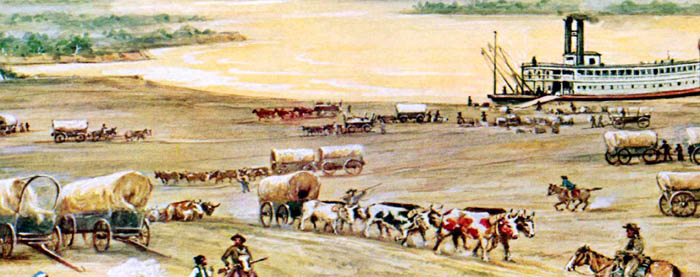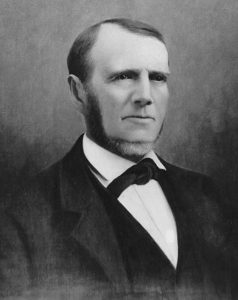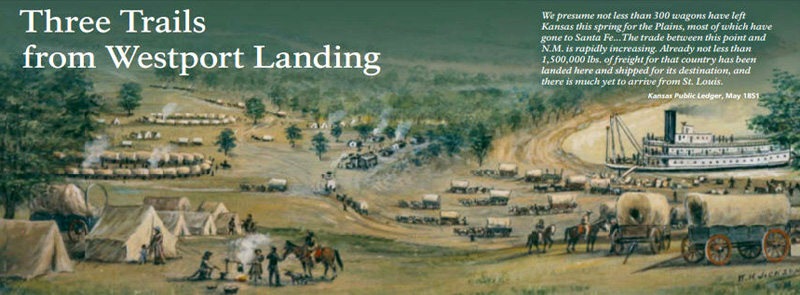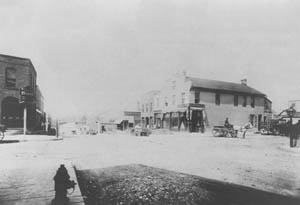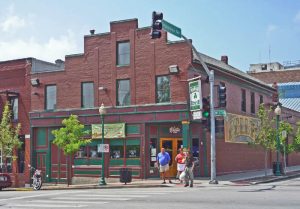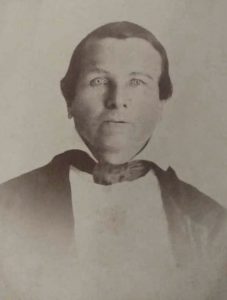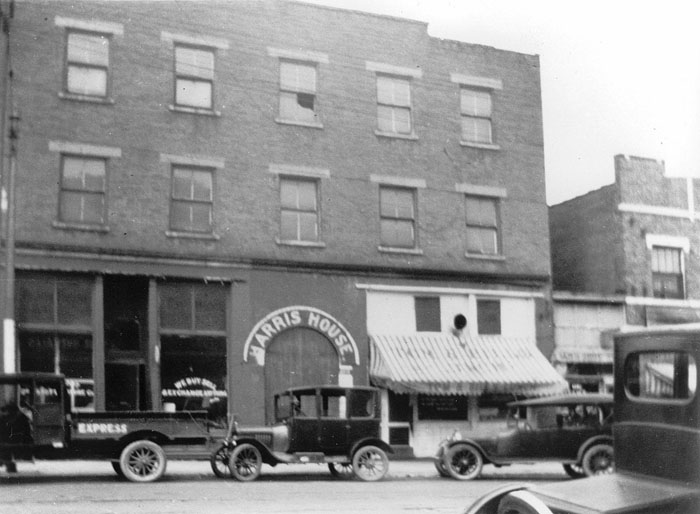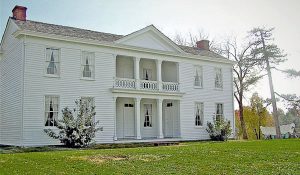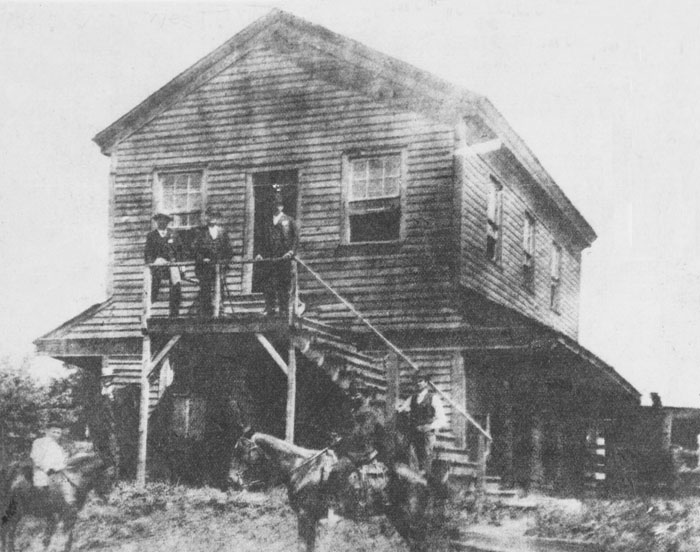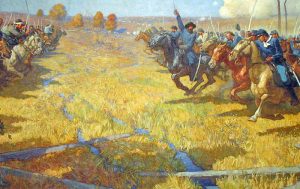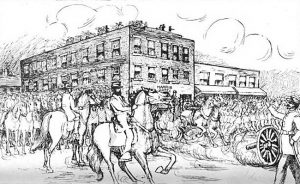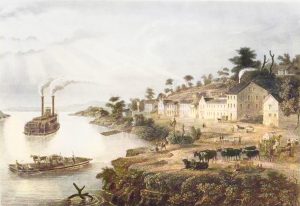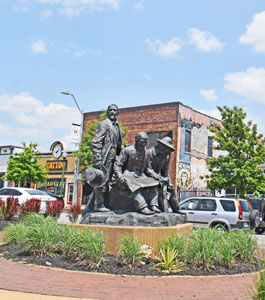“We presume not less than 300 wagons have left Kansas this spring for the Plains, most of which have gone to Santa Fe… The trade between this point and New Mexico is rapidly increasing. Already, not less than 1,500,000 lbs. of freight for that country has been landed here and shipped for its destination, and there is much yet to arrive from St. Louis.”
— Kansas Public Ledger, May 1857
Though Westport, Missouri, is a neighborhood of Kansas City today, it was once an independent, thriving town from which the California, Oregon, and Santa Fe Trails began. It was the site of one of Missouri’s most significant Civil War battles.
Since 1821, traders on the Santa Fe Trail had brought their goods by steamboat as far up the Missouri River as possible before departing on foot and in wagons for Santa Fe, New Mexico. Landings continued to move farther west along the river, and by the 1830s, Santa Fe traders disembarked at Westport Landing — just before the river’s northward bend.
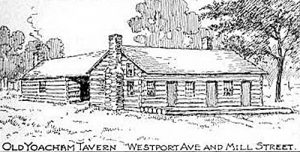
Yoacham Tavern was the first business in what would soon become Westport, Missouri. It was located at what is now Westport Avenue and Mill Street.
The first settler in the area was Daniel Yoacham, who moved with his family from Tennessee and built a log house that became the first hostelry and tavern. It was on the northwest corner of present-day Westport Road and Mill Street. At that time, a stream called Spring Branch ran south through the area. Situated near the junction of Westport Avenue and Mill Street, the hostelry was a gathering place for trappers, hunters, traders, Indians, and soldiers.
Next came Reverend Isaac McCoy and his family in December 1831, who served as Baptist Missionaries to the Indians. Reverend McCoy built a large log house on a hill at the present-day intersection of 43rd and Wornall, where St. Luke’s Hospital stands today.
In 1833, the preacher’s 22-year-old son, John Calvin McCoy, built a two-story log building on the northeast corner of Westport Road and Pennsylvania Avenue to serve as a trading post and residence. A surveyor by trade, he was destined to become the founder of Westport. He first entered the business with J. P. Hickman and J. H. Flourney to trade with the Indians and mountain men and sold supplies to wagon trains going west. Merchandise for his store came up the Missouri River on steamboats, which docked at the Wayne City Landing near Independence, Missouri, requiring McCoy to make a three-day round-trip to get supplies for his store.
To shorten his trip, McCoy found a rocky ledge outcropping on the Missouri River about four miles north of the newly founded town of Westport in the spring of 1834. He soon cut a primitive path from his store to the rocky ledge. Located between what is now Delaware and Grand Streets, he persuaded the steamboat’s captain, John Hancock, to unload the goods at the new site. This new delivery point was an eight-mile round-trip, which McCoy’s wagons could traverse in a day. This new landing site became known as Westport Landing, and McCoy soon convinced more riverboats to unload supplies and settlers closer to the trails. Thomas A. Smart opened the first trading house at the landing.
“We worked our way down the small valley… cut a wagonway through the dense brush to reach the goods, and loaded the first consignment of merchandise ever landed at the port of Kansas City.” — John C. McCoy
The same year, McCoy purchased land from Dr. Johnston Lykins, began laying streets around his store, and called the new town Westport because it was the westernmost entry point to the new frontier. A post office was established in May 1834 with McCoy appointed Postmaster, and a town plat was filed in February 1835. The mail was first carried from Independence to Westport once a week on horseback. Later, a road was built across the state from St. Louis to Westport in 1839, and the mail was brought by stage twice a week.
Because of Westport’s proximity to the Missouri River and the trails, it quickly became a popular jumping-off point to the west and the primary supply resource for the many wagon trains passing through. The outfitters supplied everything travelers needed, including food, wagons, animals, and other provisions. The new town quickly prospered and drew new people to the area. Within no time, Westport’s streets, shops, and hotels bustled with traders, trappers, missionaries, Indians, and gold prospectors forging west. Kit Carson, Jim Bridger, and John Sutter were among those of Westport who earned a place in history.
Leaving Westport, travelers heading to Santa Fe, Oregon, and California followed the same trail until they crossed the state line, passing by Shawnee Mission, Kansas, and other sites before splitting off at the trail junction west of present-day Gardner, Kansas.
Before 1836, William Chick built a brick house in Westport, a block from the Albert Boone home. Chick was among the first settlers in Westport, was a postmaster, and started the Methodist church there with his son-in-law, Reverend Nathan Scarritt, whose house remains at 40th and Central. It’s the oldest structure in Kansas City, Missouri (1847).
In 1838, 14 men, including John McCoy, William M. Chick, and mountain man William L. Sublette, purchased a 257-acre parcel for $4,220, which included Westport Landing, organized a town company, and established a municipality named the Town of Kansas, the precursor of Kansas City. In 1839, McCoy platted a 15-acre townsite. In the following years, McCoy laboriously improved the rough road from Westport to the river, and by the 1840s, Santa Fe traders began to favor Westport Landing to those farther east. By 1843, the town also had a tavern, a warehouse, and two houses; however, the town could expand no further due to a legal question on the sale of the Prudhomme estate.
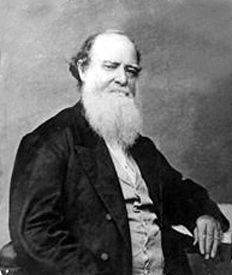
Albert Gallatin “A.G.” Boone
That same year, Albert G. Boone, the grandson of Daniel Boone, and his brother-in-law James Gillespie Hamilton began a partnership in a general merchandising operation located at the present-day corner of Westport Road and Pennsylvania Avenue in Westport. The building had been erected in 1851 and was run as a store by the Ewing Brothers until Boone and Hamilton bought it for $7,000. The outfitters supplied everything travelers needed, including food, wagons, animals, and other provisions.
The business did very well; by the 1850s, Boone’s partners included frontiersman Robert Campbell, Charles A. Warfield, and William Bernard. With the opening of the Kansas Territory in 1854, Boone became the agent of Southern pro-slavery interests for political control of the territory and was said to have been a gathering place for Border Ruffians. Boone’s reputation suffered as the tides between the southerners and the abolitionists leaned toward Kansas becoming a Free-State. In 1859, Boone sold his business to Robert Campbell, his home to James Bridger, and moved to Colorado. Today, Boone’s building still stands at 500 Westport Road. Today’s oldest building in Kansas City, the old supply store, is now Kelly’s Westport Inn, a famous tavern in the Westport neighborhood.
Commerce prospered during the Mexican-American War (1846 to 1848) with increased Santa Fe, Oregon, and California trade. The California Gold Rush of 1848 brought thousands of emigrants pushing west to the Pacific coast via Westport Landing, the town of Kansas, and Westport.
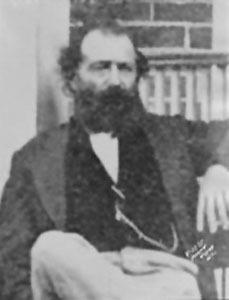
Allen McGee.
In 1846, Allen B. H. McGee, a young entrepreneur who had owned a 160-acre farm just north of Westport since 1839, built a Sac and Fox Indian Agency in Westport. After three years of successful trading, he sold his interest, bought John McCoy’s mercantile store in Westport, and enlarged it. He then used the building as a hotel unofficially known as the “Catfish House” due to the chef’s specialty of fresh-fried catfish. However, after just a little more than a year, he sold his interest to Colonel John Harris for a handsome profit in 1847.
By 1848, McGee turned his interest to the outfitting business and would work with several well-known names, including California Gold Rush pioneer John Sutter, explorer and soldier John Fremont, and mountain man Robert Campbell. Allen B.H. McGee’s outfitting business flourished for over a decade until the outbreak of the Civil War. By 45, he was retired and living off his “investments.”
An estimated 10,000 immigrants bought outfits in Westport in 1849 and 1850. Companies from all parts of the country came to Westport to organize caravans for journeys across the plains. At that time, Westport was a market for cattle, mules, horses, harnesses, tents, saddles, and all other equipment needed for travel.
Various outfitting establishments lined Westport Avenue from east of Broadway to Mill Street. Similar stores and shops were on Pennsylvania Avenue from 40th to 43rd Streets. Gold and silver bullion could be seen piled on the streets of Westport, being re-consigned and re-shipped at this point, and money was plentiful. During these times, Westport was dotted with tents and wagons and appeared as a great army camp.
Another Westport building was erected in 1850 by Cyprien Chouteau of the famous Chouteau family of fur traders who had established Chouteau’s Landing, the predecessor of Westport Landing. He opened a trading post in Westport at present-day 504 Westport Road. The building was attached to Albert G. Boone’s supply store, 500 Westport Road. Having several trading posts, Cyprian bounced back and forth between Kansas City and Kansas Territory, settling for years in Shawneetown in Johnson County. However, the Chouteaus were slave owners, and he was eventually driven out during the Bleeding Kansas struggle before the Civil War. He then fled to Kansas to a home at 412 Charlotte, which some records indicate was built by John C. McCoy. In 1866, he sold his supply store to famed mountain man Jim Bridger. The Chouteau-Bridger still stands in Westport, though heavily modified to accommodate modern operations.
In 1852, the original McCoy building that Colonel John Harris had bought from Allen McGee several years earlier burned down. Harris, who had migrated with his family from Kentucky to Westport in 1832 and prospered by buying and selling land, soon built the Harris House Hotel on the same site. Within no time, the three-story brick hotel became a famous point on the Santa Fe Trail with numerous distinguished guests, including General John C. Fremont and his wife Jesse, Kit Carson, Albert G. Boone, Seth M. Hays, Colonel Alexander W. Doniphan, Jim Bridger, General Stephen Kearny, as well as English lords, Spanish grandees, Mexicans, and Civil War heroes. The building was a historical asset and living monument to the overland trails for years, but unfortunately, it was razed in 1922.
Though Jim Bridger had long been a well-known figure in Westport, he became more involved in 1853, when the 49-year-old mountain man bought a farm near 103rd Street and State Line and brought his family to this area. Though the fur business was declining, he continued to work as a guide and scout for several years but returned to Missouri whenever possible.
In 1854, Alexander Majors, who had become the managing partner of the sizeable freighting firm Russell, Majors, and Waddell, established offices in Westport and bought the property. In 1856, he built a two-story home and freighting office at 8201 State Line Road. His farm ran alongside a dirt road known as State Line Road, the boundary between Kansas and Missouri. The strategic location enabled him to conduct business on leased property in the Kansas Territory, where he had huge corrals, grazing lands, oxen pens, barns, and wagon and blacksmith shops. Majors also operated a meat-packing plant. However, a few years later, his investment into the Pony Express in 1860 and its losses eventually killed his freighting and stagecoach operations. By 1865, Majors sold out what little remained and moved to Colorado, but when he died in 1900, his body was returned to Kansas City, where he was buried in the Union Cemetery. Today, his home has been fully restored, is on the National Register of Historic Places, and serves as a museum. The Alexander Majors House is one of only four surviving antebellum houses in Kansas City.
In 1855, John Harris built a home on a high, lovely five-acre tract on the ridge east of town. The two-story, all-brick, Greek revival house quickly became known as the “Mansion House.” The bricks and the millwork for the mansion were made on the premises. Colonel Harris’ mansion initially stood on five acres of land at the southwest corner of present-day Westport Road and Main Street, overlooking the Santa Fe, California, and Oregon Trails.
When John Harris died in 1873, his daughter Josephine and her husband, Colonel Charles Kearney, moved into the house to care for his wife. The family continued living in the home for 28 years when she died. The Harris-Kearney House was moved from its original location in 1922 to 4000 Baltimore Avenue in Kansas City. It now serves as a public museum and the office headquarters for the Westport Historical Society. Listed on the National Register of Historic Places, it is the oldest remaining original residence in Kansas City. The Westport Historical Society gives tours of the area and works with locals and business owners to keep Westport’s history alive.
Westport was incorporated in February 1857, and Major Thomas.J. Goforth was elected Westport’s first mayor. He had brought his family to Jackson County from Ohio sometime before 1850 and had served as a Justice of the Peace for Kaw Township from 1854 until 1869. When he became mayor, the Town Council often met in his small home before the Town Hall was built in 1860. He continued in the office until he died in 1882.
In 1858, Westport’s population was about 2,000.
During this time, and for several years before, Kansas Territory, just one mile to the west, was fighting to determine if it would become a Free State or a pro-slavery state. Many of these battles spilled over into Missouri, and Westport was frequently caught between the northern abolitionists and the southern sympathizers of Missouri.
Violent border fighting in the years before and during the Civil War led Westport businessmen, traders, and residents to flee to the safety of military protection in nearby St. Joseph, Missouri, and Leavenworth, Kansas, which soon became the primary jumping-off points for trade and emigration.
In 1860, Jim Bridger was said to have purchased A.G. Boone’s two-story home on Grove Street (Pennsylvania), dismantled it, loaded it onto wagons, and reassembled it upon his farm near New Santa Fe.
When the Civil War began in 1861, it brought a new level of activity to Westport. From the fall of 1861 until the spring of 1862, Colonel Charles Jennison of the 7th Kansas Calvary commandeered the Harris mansion for his headquarters. At that time, the family was removed to the Harris House Hotel.
Before the war was over, the Battle of Westport, referred to as the Gettysburg of the West, was fought on October 23, 1864, which ended the Civil War in the West. Cannon fire damaged or destroyed many Westport buildings. Union Major General Samuel Ryan Curtis had his field command post on top of the Harris House Hotel to view the battle down along Brush Creek during the battle. The Wornall House at 6115 Wornall Road was a Union and Confederate Troops field hospital. This building still stands and serves as a museum.
The battle site is two miles south of Westport’s center at Loose Park, where monuments commemorating this event can be found. It is located at 51st Street and Wornall Road.
Like other Southerners during the Civil War, John McCoy was banished from Jackson County for his political leanings and because he had a son serving in the Confederate Missouri State Guard. Young Spencer McCoy enlisted in one of General Sterling Price’s companies and died at the Battle of Springfield in January 1863. John McCoy was later allowed to return after the war but could never recover financially. He passed away in 1889 at his home at 711 Olive in Kansas City.
After the war, Westport never recovered the economic prosperity it had enjoyed during its first decades. At that point, the town of Kansas began to be the dominant community. The rise of the railroad in the post-Civil War era signaled the end of overland trails that had sustained Westport’s early commerce, and the once-thriving trade center became a small rural town when the wagon trains stopped passing through.
In 1866, Jim Bridger purchased Cyprien Chouteau’s supply store at 504 Westport Road, which his son-in-law operated. The building stands right next to Albert G. Boone’s old store and is one of the oldest buildings still standing in Westport.
In 1867, Westport’s population was 2,800, up from its 1850s count, but it dropped to just 1,500 in the next decade. Conversely, the population of Kansas City exploded, reaching 32,260 by 1870. In the meantime, Westport Landing had become obsolete. Over the years, the buildings disappeared, weeds and trash accumulated, concrete covered the rock ledge, railroad tracks traversed the area, and a concrete flood wall was constructed.
The town of Westport was annexed to Kansas City in 1897. New commercial buildings replaced older residential and commercial buildings in the following decades, lining Westport Road and side roads.
Westport, however, had already made its mark on Western history. Though very little of the original frontier village is left, its history can still be seen in old-style lampposts, tree-lined boulevards, historic buildings, and a walking trail with historical markers that recount its storied history and the Battle of Westport. Today, it is a thriving entertainment and shopping district with unique restaurants, charming boutiques, and hot nightspots interwoven with remnants of the area’s historical past.
©Kathy Alexander/Legends of America, updated April 2024.
Also See:
John C. McCoy – Founder of Westport, Missouri
Santa Fe Trail – Pathway to the Southwest
Sources:
Santa Fe Trail Research (website no longer active)
Santa Fe Trailer
Westport Historical
Visit K.C.
Westport Improvement Association; Westport 1812-1912, Franklin Hudson Publishing Co., Kansas City, Mo.
Wikipedia

